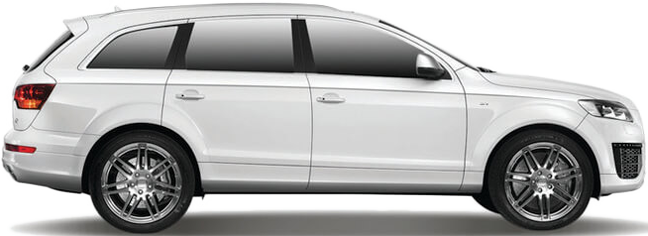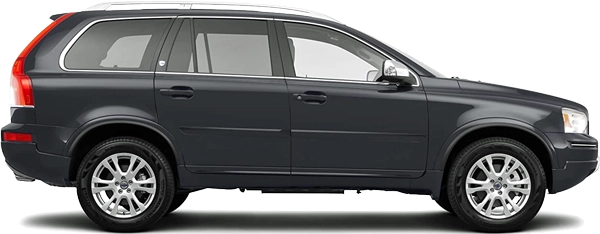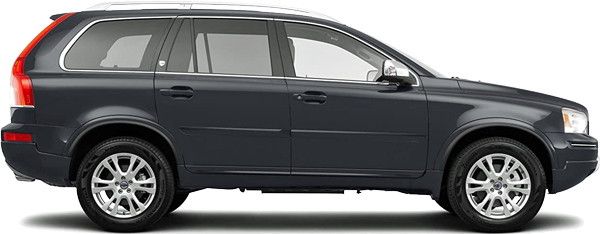The Comparative Analysis :
Audi Q7 3.6 FSI quattro tiptronic (09 - 10) vs. Volvo XC90 3.2 AWD Geartronic (7-seater) (11 - 12)
€ 51,800

€ 48,800

€ 51,800
Base Price ⓘBase price of a new vehicle with standard equipment in Germany at market launch.
€ 48,800
ⓘBase price of a new vehicle with standard equipment in Germany at market launch. Price Info
Vehicle Dimensions
The dimensions of these vehicles differ considerably. The Audi Q7 3.6 FSI is 28.2 cm longer, 8.5 cm wider and 4.7 cm lower than the Volvo XC90 3.2.
Audi Q7 3.6 FSI
Volvo XC90 3.2
1737
1983
2177
1784
1898
2110
1983 mm
Width
1898 mm
2177 mm
Width Incl. Mirrors
2110 mm
1737 mm
Height
1784 mm
3002
5089
2857
4807
5089 mm
Length
4807 mm
3002 mm
Wheelbase
2857 mm
Vehicle Weight
Audi Q7 3.6 FSI
Volvo XC90 3.2
2280 kg
Kerb Weight
2202 kg
2930 kg
Gross Vehicle
Weight
Weight
2760 kg

Weight Difference:
78 kg
3.42 %

General
Audi Q7 3.6 FSI
Volvo XC90 3.2
4L
Generation
C
Sport Utility Vehicle
Car Body Style
Sport Utility Vehicle
Super Unleaded (98 RON)
Fuel Type
Unleaded (95 RON)

Permanent all-wheel drive
Drive
On-demand four-wheel drive with automatic engagement

6-speed automatic transmission
Transmission
6-speed automatic transmission
Engine
Audi Q7 3.6 FSI
Volvo XC90 3.2
V6 petrol engine (naturally aspirated engine)
Engine Type
Straight-six petrol engine (naturally aspirated engine)
BHK
Engine Code
B6324S5
4
Valves
4
6
Cylinders
6
3597 CC
Engine Capacity
3192 CC
276 bhp
at 6200 rpm
Power
240 bhp
at 6400 rpm
Audi Q7 3.6 FSI
276 bhp
240 bhp
Volvo XC90 3.2
360 NM
at 2500 rpm
Max. Torque
320 NM
at 3200 rpm
Audi Q7 3.6 FSI
360 NM
320 NM
Volvo XC90 3.2
Performance
Audi Q7 3.6 FSI
Volvo XC90 3.2
140 mph
Maximum Speed
130 mph
8.5 sec
Acceleration 0 to 62 mph
9.5 sec
62 mph
62
mph
mph
118 m
0.000 sec

Audi Q7 3.6 FSI
62 mph
62
mph
mph
132 m
0.000 sec

Volvo XC90 3.2
▶ REPLAY
8.26 kg/bhp
Weight-to-Power Ratio
9.18 kg/bhp
Audi Q7 3.6 FSI
8.26 kg/bhp
9.18 kg/bhp
Volvo XC90 3.2
Fuel Economy / Emissions
Audi Q7 3.6 FSI
Volvo XC90 3.2
Fuel Economy
23 mpg
combined
25 mpg
Audi Q7 3.6 FSI
23 mpg
25 mpg
Volvo XC90 3.2
17 mpg
city
18 mpg
No data
motorway
32 mpg
100 L
Fuel Tank Capacity
80 L
513 mi
Range
432 mi
Audi Q7 3.6 FSI
513 mi
432 mi
Volvo XC90 3.2
Environmental Impact
229.2 kWh
Total Energy Consumption
per 100 miles ⓘThe total energy consumption per 100 miles is the amount of energy consumed by a vehicle when burning fuel or using electricity per 100 miles (final energy), and the energy required to produce the appropriate amount of fuel or electricity (primary energy).
per 100 miles ⓘThe total energy consumption per 100 miles is the amount of energy consumed by a vehicle when burning fuel or using electricity per 100 miles (final energy), and the energy required to produce the appropriate amount of fuel or electricity (primary energy).
217.9 kWh
Audi Q7 3.6 FSI
229.2 kWh
217.9 kWh
Volvo XC90 3.2
Euro 4 III
Emission Standard
Euro 5
289 g/km (NEFZ)
CO2 Emissions
269 g/km (NEFZ)
Practical Convenience
Audi Q7 3.6 FSI
Volvo XC90 3.2
5
Doors
5
5
No. of Seats
7
650 kg
Maximum Payload
558 kg
775 L
Boot Capacity
249 L











2035 L
Boot Capacity (Seats Down)
1837 L













